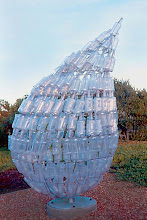As we discovered through our discussion in class today, site-specific art is a difficult concept to approach. In its most basic sense, site-specific art is artwork created to exist in a certain place. The combination of the work of art and the places in which it is located define its meaning. From this, we can gather that the site-specific work creates a sort of "relationship" with its location.
This idea of site-specificity raises several questions. To respond to Serra's quote above, do you think moving a piece of art destroys it? Or does it only change the significance of the piece? Perhaps for an artist, changing the significance of the work is to destroy it.
We brought up the image of Wait Chapel and the significance of its location on campus. Placed in a prime location on the Reynolda Campus, it is situated at the “heart of a cross” (aligning it on the grid which defines the campus architecture) where everyone can easily view it. Chiefly significant because it connects the viewer with the religious identity (Baptist affiliation) that Wake Forest University once had, if placed in an entirely different setting, would Wait Chapel lose its significance? In this case, is the work site-specific or is it culturally and/or socially-specific?










No comments:
Post a Comment